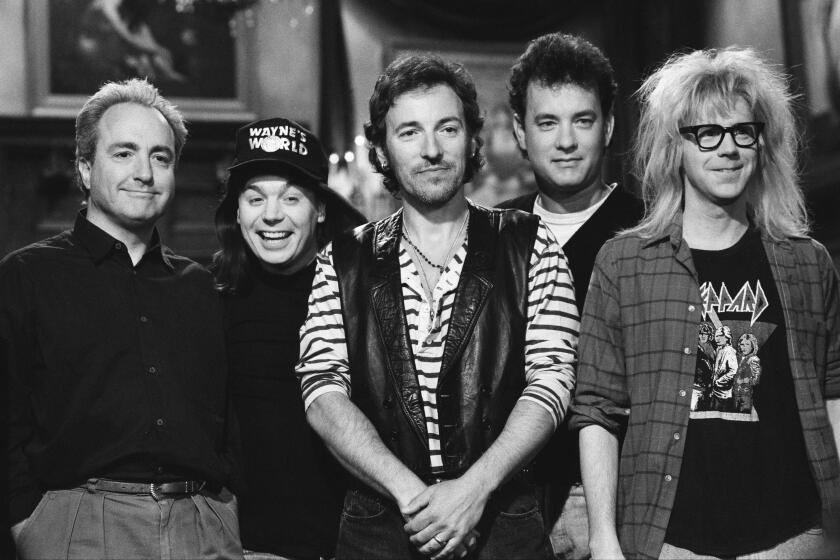Swinging on a Starlet : VENUS BLUE, <i> By Gustaf Sobin (Little, Brown: $19.95; 250 pp.)</i>
- Share via
In newspapers and on television we hear every day about the devotional mania inspired by certain Hollywood celebrities, of the gawkers, the collectors, the occasional insane admirer who attempts to break through the necessary distance between worshiper and idol. In his first novel, poet Gustaf Sobin has cast just such figures.
Stefan Hollander is a collector of Hollywood memorabilia with a particular fixation on the starlet Molly Lamanna. He stumbles across the only copy of a private memoir written by the screenwriter wife of Lamanna’s producer. The manuscript, which is reproduced in its entirety in Sobin’s fiction, has been stolen, and Hollander’s attempts to search out the facts that might lead to his retaining it or returning it to its proper owner interweaves his life with that of his idol, Molly.
The real Molly Lamanna, as the memoir gradually reveals, is as ghostly and unknowable as the celluloid images that preserve her short-lived career in B movies. Molly is a woman without a past, an ingenue who in her natural grace and unstudied, animal-like innocence arouses in her lovers a desperate desire to surround and protect.
Such an admirer is Millicent Rappaport, author of the disputed memoir. Her manuscript is the search for the true Molly in the unreal world of Hollywood. The story-within-the-story is the per-fect form for a Hollywood novel: Where is the image, where is the reality? Molly has a stand-in, Vivien Voight, identical except for the birthmark she burned on her cheek to match a photograph of Molly--not knowing that photograph had been snapped through a mirror. There is the usual mix of double-cross, amnesia, sex and money.
Without sacrificing anything to the popular form in which he is working, Sobin manages to turn his material also to more literary themes. Paralleling the attempt to discover Molly Lamanna’s history is an inquiry into language, the means of art to define and describe its subject. As Millicent’s husband the producer declares, if there is anyone who can create the words to comprehend Molly it is his screen-writer wife.
Millicent is aware that she can never consummate her love for Molly in real life. So for her language becomes an almost sexual tool. The journal she creates is, as she describes it, “A refuge. A room within the very room one lives in. An intimacy. A place where one can finally lay out one’s most inadmissible secrets, unroll them like so much coveted brocade.”
At work at her own screenplay rewrite of the B movie “Mongol Moon,” Millicent attempts to rewrite history, to stave off Genghis Khan’s extermination of Samarkand through his fictional love of an Islamic princess.
Sobin places the story in the months leading up to Pearl Harbor, and as the reader observes the inevitable chain of events, the impossibility of changing history becomes evident--likewise the course of a human destiny.
But Millicent is unwilling to give up her obsession. Her love has turned into a mania similar to Hollander’s collector’s mania. Against reason, she flies to Europe at the moment of the first Nazi invasions. At Antibes she encounters an Italian Jew who reveals the secret of Molly Lamanna.
Millicent rushes back to the States with this news. Like the surrounding war, she would destroy innocence--but Molly escapes. As Millicent writes, “She seems to slip, each time, through logic, language, through all the systems we’ve ever invented for the simple purpose of determining, with increasing rigor, our arbitrary realities. That I might reduce her . . . to ‘a single, perfectly observant, penetrating remark,’ was, and remains, now, utterly factitious.”
Even when the secrets in this novel are revealed, the reader is no closer to being able to understand, to recreate the magnificent Molly than he was at the book’s first glimpse of her in flannel trousers and slate-gray satin blouse. She is a mannequin, a doll to be dressed up and moved around. Neither author, nor literary characters, nor reader can bring her to life.
But it is, finally, that very fact, given this novel’s intense visual presentation and focus, that is one of the most fascinating aspects of Sobin’s work. “Venus Blue” is less a novel about filmmaking than it is a film cloaked in the language of fiction. As Sobin unpacks his plot like so many Chinese boxes, the reader becomes less and less interested in “truth,” the history in which these characters and mannequins are trapped, than in the series of images it presents--the frames of its film.
Sobin even ends with an image that nods, almost comically, to the ending of hundreds of Hollywood films: “As I walked to the car, I heard, somewhere over the low cloud front . . . the drone of a single-engine, propeller-powered airplane, traveling westward . . . I’d heard the airplane emerge out of nowhere. And now, still invisible, still covered by the low-lying cloud bank, it vanished into nowhere as well. I followed it, from the parking lot, until it had grown, along with its message, entirely inaudible. Until it was well past my hearing.”
Swell of music, credits.
More to Read
Sign up for our Book Club newsletter
Get the latest news, events and more from the Los Angeles Times Book Club, and help us get L.A. reading and talking.
You may occasionally receive promotional content from the Los Angeles Times.







